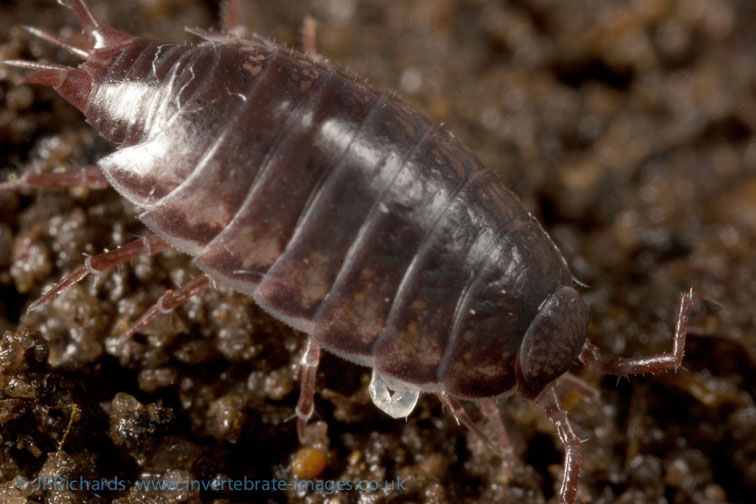Oritoniscus flavus (Budde-Lund, 1906)
Status:
- GB IUCN status: Not applicable (non-native)
- GB rarity status: Naturalised
ID Difficulty
Identification
The pygmy woodlice of family Trichoniscidae (and Styloniscidae) are readily distinguished from other woodlice by the shape of the antennal fagellum which comprises a tapered cone (of indistinct segments) bearing a terminal bristle.
Oritoniscus flavus is a dark purplish-red species, capable of rapid movement, somewhat reminiscent of a very large Trichoniscus pusillus agg. or a very dark Philoscia spp. However, it differs from both (in addition to other characters) in the eye being composed of a single prominent ommatidium and both eye and body pigments fading rapidly in alcohol to a pale straw colour. The recently discovered Hyloniscus riparius could be mistaken for this species.
Distribution
Oritoniscus flavus is virtually confined to Ireland, where it is locally common across much of the south-east.
It was unknown in Britain until 1994 when a site was discovered in south Wales (BISG Newsletter 37, pg.1). In 2010 a population was discovered in Mid-Lothian, Scotland (Sivell & Gregory, 2012) and a detailed account of its occurrence there is given by Maguire (2020).
Habitat
It is characteristically associated with river and stream valleys, often inhabiting rough vegetation beside watercourses, where it occurs among damp leaf litter, and under stones and dead wood.
This updated summary is based on the detailed account in Gregory (2009).
References
Maguire, W. (2020) The distribution of Oritoniscus flavus (Budde-Lund 1906) in VC83 Midlothian (Isopoda: Oniscidea: Trichoniscidae) Bulletin of the British Myriapod & Isopod Group 32: 59-64.
Sivell, D. & Gregory, S.J. (2012) Oritoniscus flavus - a woodlouse new to Scotland. Bulletin of the British Myriapod & Isopod Group 28: 44-49.
Gregory, S. (2009) Woodlice and Waterlice (Isopoda: Oniscidea & Asellota) in Britain and Ireland. Field Studies Council/Centre for Ecology & Hydrology.
Links
World List of Marine, Freshwater and Terrestrial Isopod Crustaceans: https://www.marinespecies.org/isopoda/aphia.php?p=taxdetails&id=261643









